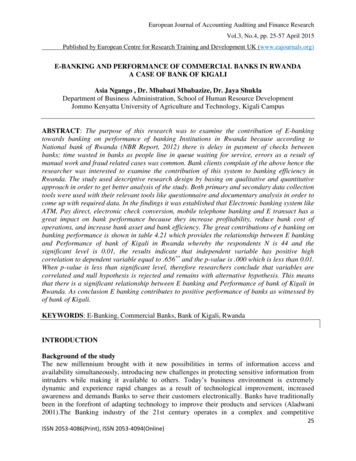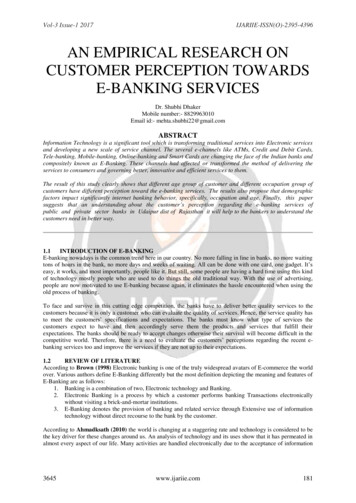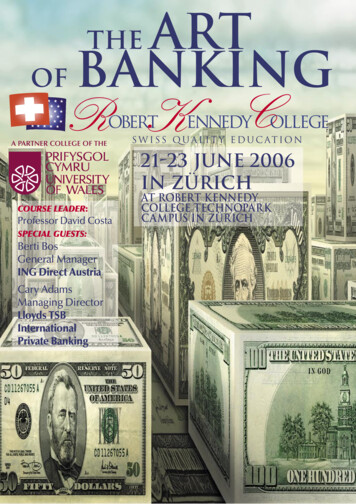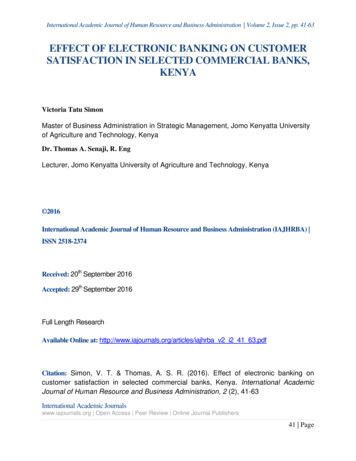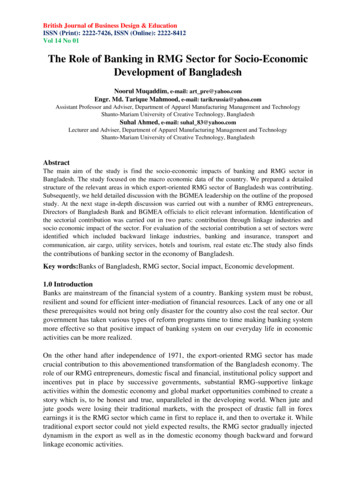
Transcription
British Journal of Business Design & EducationISSN (Print): 2222-7426, ISSN (Online): 2222-8412Vol 14 No 01The Role of Banking in RMG Sector for Socio-EconomicDevelopment of BangladeshNoorul Muqaddim, e-mail: art pre@yahoo.comEngr. Md. Tarique Mahmood, e-mail: tarikrussia@yahoo.comAssistant Professor and Adviser, Department of Apparel Manufacturing Management and TechnologyShanto-Mariam University of Creative Technology, BangladeshSuhal Ahmed, e-mail: suhal 83@yahoo.comLecturer and Adviser, Department of Apparel Manufacturing Management and TechnologyShanto-Mariam University of Creative Technology, BangladeshAbstractThe main aim of the study is find the socio-economic impacts of banking and RMG sector inBangladesh. The study focused on the macro economic data of the country. We prepared a detailedstructure of the relevant areas in which export-oriented RMG sector of Bangladesh was contributing.Subsequently, we held detailed discussion with the BGMEA leadership on the outline of the proposedstudy. At the next stage in-depth discussion was carried out with a number of RMG entrepreneurs,Directors of Bangladesh Bank and BGMEA officials to elicit relevant information. Identification ofthe sectorial contribution was carried out in two parts: contribution through linkage industries andsocio economic impact of the sector. For evaluation of the sectorial contribution a set of sectors wereidentified which included backward linkage industries, banking and insurance, transport andcommunication, air cargo, utility services, hotels and tourism, real estate etc.The study also findsthe contributions of banking sector in the economy of Bangladesh.Key words:Banks of Bangladesh, RMG sector, Social impact, Economic development.1.0 IntroductionBanks are mainstream of the financial system of a country. Banking system must be robust,resilient and sound for efficient inter-mediation of financial resources. Lack of any one or allthese prerequisites would not bring only disaster for the country also cost the real sector. Ourgovernment has taken various types of reform programs time to time making banking systemmore effective so that positive impact of banking system on our everyday life in economicactivities can be more realized.On the other hand after independence of 1971, the export-oriented RMG sector has madecrucial contribution to this abovementioned transformation of the Bangladesh economy. Therole of our RMG entrepreneurs, domestic fiscal and financial, institutional policy support andincentives put in place by successive governments, substantial RMG-supportive linkageactivities within the domestic economy and global market opportunities combined to create astory which is, to be honest and true, unparalleled in the developing world. When jute andjute goods were losing their traditional markets, with the prospect of drastic fall in forexearnings it is the RMG sector which came in first to replace it, and then to overtake it. Whiletraditional export sector could not yield expected results, the RMG sector gradually injecteddynamism in the export as well as in the domestic economy though backward and forwardlinkage economic activities.
British Journal of Business Design & EducationISSN (Print): 2222-7426, ISSN (Online): 2222-8412Vol 14 No 012.0 Objectives of the Studya. To find the current impacts in the economy of Bangladesh by current bankingactivities.b. To investigate the historical impacts of RMG sector in Bangladesh economy.c. To discover the social impacts of the RMG sector in Bangladesh.3.0 Literature ReviewSeveral authors have analyzed aspects of the garment industry in Bangladesh. Of the variousaspects of the industry, the problems and the working conditions of workers have receivedthe greatest attention.Paul-majumder (2007) found that demand for weekly holiday is a major reason for worker’sunrest during 2006. It is observed that the workers are engaged in work for all most all days.Abdin M. J. (2008) in his journal “Overall Problems and Prospects of Bangladeshi ReadyMade Garments Industries” focused on labor unrest is RMG sector and provide some solutionregarding this problem. Sultana S. and et al (2011) presents results from a survey of “LikelyImpacts of Quota Policy on RMG Export from Bangladesh: Prediction and the Reality”which indicates that despite the concern and fear of negative impact on in the aftermath ofquota removal of RMG sector in Bangladesh appears with positive trends along with thesubstantial increasing rate of export amount, the number of jobs and industries and GDP’sgrowth. In 2010, the sector keeps around 20 percent GDP growth of the country.In another study, Ferdous R. (2012) found that the reason behind the labor unrest is theabsence of legal and institutional arrangements to ensure labor rights in the RMG sector.Many of the garments factories in Bangladesh are alleged not to comply with the Labor Lawand ILO conventions. The main reason for labor unrest is inadequate wages of the workers.Islam M. S, and Ahmad (2010) identified that conveyance, lunch bill and enhancement ofcasual leave, increase of monthly minimum wages from tk. 1662 to tk. 5000; low house rentand better supply of water and gas are the reasons for the labor unrest in the ready-madegarment industry of Bangladesh. In another study, Mirdha R. U. (2012) found that the rumor,fear of job loss, false business, case with police stations, fear of shutdown of factories,arrears, checking at entry point and identity cards, pay hike and discrimination in grades, badrelation with workers and mid-level management, provocation by locally influential peopleand international conspirators and some NGOs, fear of police and role of industrial police,sudden order cut by international buyers, production in piece rate, accommodation and higherhouse rent, lack of motivational training program, inflation etc. are also the reasons for laborunrest in ready-made industry of Bangladesh.A McKinsey survey also tells us that the potential for the garment industry is promising.McKinsey forecasted export-value growth of 7-9 percent annually within the next ten years,so the market will be double by 2015 and nearly triple by 2020.There are several external factors that have been playing an important role in facilitating thegrowth of the sector. One of these crucial factors is gradual reduction in China's bulk
British Journal of Business Design & EducationISSN (Print): 2222-7426, ISSN (Online): 2222-8412Vol 14 No 01production due to labor shortages and higher wages, which also contribute to a decline in itsappeal in the apparel realm. Moreover, China is now interested in manufacturing productsthat require greater skills, better technology and more investment in advanced equipment.According to a survey conducted by McKinsey in 2001, 86 percent of the chief purchasingofficers in leading apparel companies in Europe and the US planned to decrease levels ofsourcing in China over the next five years because of declining profit margins and capacityconstraints, and their next preferred sourcing destination is Bangladesh. They viewedBangladesh as the next hot spot for sourcing in the RMG market. So Bangladesh is expectedto gain much from the changed scenario in the global apparel market.Kattel, I. K. (2015) evaluated the Financial Solvency of Selected Commercial Banks of Nepalusing application of Bankometer covering the period 2007- 2012. The study found that all theprivate and joint venture banks are in sound financial position and private sector banks arefinancially sounder in comparison to joint venture banks. The study also concludes that thisrecent model for financial soundness measurement will help the bank's internal managementin mitigating the insolvency issues by proper control and supervision system at theoperational level.Qamruzzaman, M. (2014) tried to predict bankruptcy of selected private commercial Banks inBangladesh using “Bankometer’s S-score and Altman “Z-score” model. For analyzing thefinancial position of banks the researcher took 20 banks as sample from 30 listed privatecommercial banks in Dhaka Stock. His study found that both Bankometer’s S-score andAltman Z-score show similar results about financial position in year 2008, 2009 and 2010 butexceptions prevail in year 2011 and 2012. Although, Altman Z-score model shows slightlybankruptcy status but S-score model shows as a whole banking industry hold a very healthyfinancial status according to his study.Anita Erari, Ubud Salim, SyafieIdrus. M. &Djumahir (2013) used different models namelyCAEL, Zscore and Bankometer for assessing financial performance of P.T Bank Papuacovering the period 2003-2011. His study shows that both CAEL and Bankometer haverevealed same assessment in determining financial position but Altman’s Z-score model hasreversely put Papua banking industry in to gray zone. This research also suggested that Zscore model is not suitable for evaluation of banking industry having some limitations.However, the study concluded that Z-score model provides early indication about bankruptcyin assessing financial performance and based on the results of above mentioned three models;Bank Papua’s profitability is good.Makkar, A., & Singh, S. (2012) attempted a study with a model named Bankometer toevaluate the solvency of 37 Indian commercial banks covering the period of 2006-07 and2010-11.The researcher used Bankometer to check whether analyzing the vulnerability offinancial distress on the banks is better than the conventional methods like CAMELS andCLSA Stress test. His study found that all the Indian banks are financially solvent and alsorevealed that private sector banks are financially more sound than public sector banks. This
British Journal of Business Design & EducationISSN (Print): 2222-7426, ISSN (Online): 2222-8412Vol 14 No 01study also indentified some unperformed banks and also concluded that Bankometer modelwill assist internal management in avoiding insolvency issues.Arulvel and Balaputhiran (2013) initiated a study of financial performance analysis onbanking sector of Sri Lanka. The study covered the period 2006-2010 and assessed financialperformance of private and state owned banks by applying different statistical tools like DataEnvironmental Analysis, CAMELS and Bankometer. The study found that state owned banksare performing better than the commercial banks as per Bankometer approach.Shar, A. H., Shah, M. A., &Jamali, H. (2010) evaluated the performance of banking sector inPakistan using a new model named Bankometer model which is recommended by IMF. Inthis study the model Bankometer has been applied on individual banks covering the period1999-2002 for evaluating the solvency of each bank in Pakistan. The results have beencompared with CAMEL and CLSA-stress test for conducting better comparison. His studyconcluded that Bankometer’s s-score scale can be applied at global level to predict thevulnerability of an individual bank.Altman (1968) conducted his first study on corporate bankruptcy assessment using financialratios analysis as tools that showed 90% rate of accuracy in correctly classifying thebankrupted firms and 80% rate of accuracy in predicting the next financial difficulties.Although, Altman’s Z-score model was initially developed for predicting bankruptcy ofmanufacturing organizations attaining 80% accuracy but later the model came with additionalmodifications for assessing bankruptcy of banking sector and successfully showed 70%accuracy rate of prediction. Altman Z-score model has been used by many researchers topredict financial distress and evaluate soundness of financial institutions over the period.4.0 History of RMG industry in BangladeshBangladesh has a population of approximately 168 million people. The economy ofBangladesh is significantly dependent on agriculture. But it’s a great news for the countrythat, (RMG) Ready Made Garments sector of Bangladesh has raised as the biggest earner offoreign currency. This sector creates about 4.2 million employment opportunities andcontributes significantly to the GDP. Ready-made garments (RMG) of Bangladesh ispowered by young, urbanizing, workers, where most of them are women.The foundation of textile sector was first established in the 60th decade of 19th century. Forthe first time, the industry exported shirts (Mercury shirt) to the European market in 1965-66,which was produced from Karachi. In the latter, 9 exporting industries were available in1977-78. The three largest industries in that time were Riaz Garments, Jewel Garments andParis Garments. Among those, Riaz Garments was the most famous and oldest industry inthat time.In the earlier stage, Riaz Garments of Mohammad Reaz Uddin started its business with sometailoring shop in the name of Riaz store. In the later, the name turned into Riaz Garmentsfrom Riaz store in 1973 and from 1978 the company started exporting products in the abroadby exporting 1 million pieces of shirts in the South Korean Company named “Olanda”. “Desh
British Journal of Business Design & EducationISSN (Print): 2222-7426, ISSN (Online): 2222-8412Vol 14 No 01Garments” is another pioneer of Bangladesh RMG sector. In 1979, Desh Garments started ajoint project with South Korean company “Daiyuu”.At the same time, several garments were introduced such as-Stylecraft limited by ShamsurRahman, AristocraftLimitd by AM Subid Ali, Azim Group by Engineer Mohammad FazlulAzim and Sunman Group by Major (Retd) Abdul Mannan.By following the beginners of RMG sector, some others discreet and hard-workingentrepreneurs started their RMG business in the country. From there, RMG sector ofBangladesh was developing day by day and not needed to look back. Though this sector hadpassed various critical stages through the path. In that time, we learned about child labor1994 and in 1995 we made our garments industry free from child labor very successfully.5.0 Present Situation of RMG Sector in BangladeshQuota system was a great blessing for establishing our garments industry. We were stronglybenefited by using that. As a result we can see a matured garments industry today. But whilequota system was approaching to an end in 2004, there’s so many got upset about the RMGsector of Bangladesh. Though in the latter it can’t be affected here as the experts wereseemed. We conquered the post quota challenges and made that a successful story.In RMG sector of Bangladesh, there are more than 5000 garment factories (private statistics)at the current time, employing more than 12 lack labors, where 85% of the labor force iswomen. But, according to BGMEA the number of garment factories in Bangladesh around4000. Now, RMG industry is the country’s largest export earner with the value of over 24.49bn of exports in the last financial year. It’s a great news for us that, Bangladesh isclearly ahead from other South Asian suppliers in terms of capacity of the ready-madegarments industry.Though, there are various types of garments are manufactured in Bangladesh, but all theready-made garments are classified into two broad categories, where one is woven productsand another one is knitted products. Woven products includes Shirts, Pants and Trousers. Onthe other hand, knitted product includes T-Shirts, Polo Shirts, Undergarments, Socks,Stockings and Sweaters. Woven garments still dominates the export earnings of the country.From BGMEA website it’s seen that, Day by day knitted items production is increasing inconsiderable rate and now about 40% export earnings has achieved from knitted products.6.0 Historical background of banking sector in BangladeshAfter the independence, banking industry in Bangladesh started its journey with 6nationalized commercialized banks, 2state owned specialized banks and 3 foreign Banks. Inthe 1980s banking industry achieved significant expansion with the entrance of private banks.Now, banking sector in Bangladesh is primarily of two types:A). Schedule BankB). Non-schedule Bank
British Journal of Business Design & EducationISSN (Print): 2222-7426, ISSN (Online): 2222-8412Vol 14 No 01A). Scheduled Bank: The banks which get license to operate under Bank Company Act, 1991(Amended in 2003) are termed as Scheduled Bank. State-owned commercial banks, privatecommercial banks, Islamic commercial banks, foreign commercial banks and somespecialized banks are Scheduled Bank.B). Non-Scheduled Bank: The banks which are established for special and definite objectiveand operate under the acts that are enacted for meeting up those objectives are termed asNon-Scheduled Bank. These banks cannot perform all functions as like as scheduled banks.Grameen Bank, ProbashiKallyan Bank, Karmasangsthan Bank, Progoti Co-operative LandDevelopment Bank Limited (progoti Bank) and Answer VDP Unnayan Bank are NonScheduled Bank.6.1 List of Banks in BangladeshState Owned Banks1. Sonali Bank Ltd.2. Agrani Bank Ltd.3. Rupali Bank Ltd.4. Janata Bank Ltd.5.6.7.Bangladesh DevelopmentLimited.Basic Bank LimitedBangladeshKrishiBankBankPrivate Commercial Banks1. AB Bank Limited2. BangladeshCommerceBankLimited3. Bank Asia Limited4. Bengal Bank Limited5. BRAC Bank Limited6. City Bank Limited7. Dhaka Bank Limited8. Dutch-Bangla Bank Limited9. Eastern Bank Limited10. IFIC Bank Limited11. Jamuna Bank Limited12. Meghna Bank Limited13. Mercantile Bank Limited14. Midland Bank15. Modhumoti Bank Limited16. Mutual Trust Bank Limited17. National Bank Limited18. National Credit & Commerce BankLimited19. NRB Bank Limited20. NRB Commercial Bank Limited21. One Bank Limited22. Premier Bank Limited23. Prime Bank Limited24. Pubali Bank Limited25. South Bangla Agriculture &Commerce Bank Limited26. Southeast Bank Limited27. Standard Bank Limited28. The Farmers Bank Limited29. Trust Bank Limited30. United Commercial Bank Limited31. Uttara Bank Limited32. Shimanto Bank LtdIslamic Commercial Private Banks1. IslamiSomaz Bank Limited2. Al-ArafahIslami Bank Limited3. EXIM Bank Limited4. First Security Islami Bank Limited5. ICB Islamic Bank Limited6.7.8.9.Islami Bank Bangladesh LimitedShahjalalIslami Bank LimitedSocial Islami Bank LimitedUnion Bank Limited
British Journal of Business Design & EducationISSN (Print): 2222-7426, ISSN (Online): 2222-8412Vol 14 No 01Foreign Commercial Banks1. Bank Al-Falah Limited2. Citibank N.A3. Commercial Bank of Ceylon PLC4. Habib Bank Limited5. National Bank of Pakistan6.7.8.9.10.Standard Chartered BankState Bank of IndiaPunjab National BankWoori BankHSBCNon-Scheduled Banks1. Ansar VDP Unnayan Bank2. Karmashangosthan Bank3. ProbashiKollyan Bank4.5.6.Grameen BankJubilee BankPalliSanchay Bank7.0 Methodology of the StudyThe present study has made use of both primary and secondary sources of information. As aninitial input, we prepared a detailed structure of the relevant areas in which export-orientedRMG sector of Bangladesh was contributing. Subsequently, we held detailed discussion withthe BGMEA leadership on the outline of the proposed study and its methodology. At thesecond stage in-depth discussion was carried out with a number of RMG entrepreneurs,Directors of Bangladesh Bank and BGMEA officials to elicit relevant information.After the debriefing of the key informants, we conducted a survey of selected RMG units andmade a detailed analysis of the statements of accounts of 15 RMG units, both woven and knit.The information was cross-checked with other available sources. The study team madeexclusive use of Trade Related database. Information received from various secondarysources including the EPB, NBR, Bureau of Statistics, Bangladesh Bank and CommercialBanks, various chambers was also consulted.On the basis of the primary data generated for the purpose of the study and also the secondaryinformation, we carried out an in-depth study of the contribution of the RMG industry to theoverall economy of the country and also to the various sub-sectors of the economy. Datagenerated from the sample survey served as the basis for these estimates. The estimatescomputed from the sample were then blown up by using the share of the various componentsin the export earnings of the sample units. These shares were then used to arrive at therelative contribution of the various components in the total earnings of the RMG sector forthe year FY2017. Identification of the sectorial contribution was carried out in two parts:contribution through linkage industries and socio economic impact of the sector. Forevaluation of the sectorial contribution a set of sectors were identified which includedbackward linkage industries, banking and insurance, transport and communication, ports,shipping, air cargo, utility services, hotels and tourism, real estate etc. The estimates werecross-checked with information from other sources mentioned above for consistency and,where possible, for accuracy.8.0 Findings of the study8.1 Sectorial basis:8.1.1 Banking and Insurance
British Journal of Business Design & EducationISSN (Print): 2222-7426, ISSN (Online): 2222-8412Vol 14 No 01Growth of the RMG sector and the related activities has contributed a lot to the robust growthof the financial sector in Bangladesh. In FY 2017 the banking sector earned about 64 milliondollars from business with the RMG sector in the form of interest and charges and L/Ccharges. More than one-tenth of the commercial banks’ asset portfolio belongs to the RMGand textile sector in the country. In FY 2017 commercial banks lent Taka 5400 crore to thetextile sector, while the amount lent to the woven-RMG sector was Taka 1212 crore. Theexport financing business of the commercial banks is largely dependent on the textile andRMG sectors. The RMG sector received Taka 5175 crore as export-finance in FY 2017which was 66.14% of the total export financing portfolio of the banks. A World Bank surveyrevealed that almost all firms (98%) are the clients of the commercial banks for workingcapital and procurement of machines and equipment (57%). The RMG sector has alsocontributed to the growth of the country’s insurance sector. On average, every year thepremium paid by the RMG sector to the insurance companies was about 6 million dollars. Allfirms have their machines and plants insured and, additionally, 87% of importers of input and15% of the RMG exporters get their imports/exports insured.8.1.2 Transport CommunicationThe growth and development of inland transport services to a considerable extent owe to thegrowth of the RMG industry. Both wheel transport service and railway service are widelyused by RMG sector for activities related to manufacturing and cargo movement. Theconcept of covered van emerged in Bangladesh for safe transportation of the RMG productsin particular. In 2002 the inland transport industry received about 27.3 million dollars asrevenue from the RMG sector.8.1.3 Professional ServicesThe RMG sector extensively uses professional services from CA firms, legal agencies,business consultants. In FY 2017 total payment for professional services is estimated at 6.61million dollars.8.1.4 Engineering SectorThe RMG industry paid 24.2 million dollars to the engineering sector which includedpayments to repairing and maintenance service industry (USD 4.29 million), electricalengineering (USD 4.38 million), transport vehicle maintenance service ( USD 2.87 Million),and machine tools service (USD 2.63 Million).8.1.5 Information and Communication TechnologyThe RMG sector also plays a catalytic role in the growth of the country’s ICT sector. Theservices consumed by the RMG industry generated revenue for the ICT sector. Payments forICT services which include communication, hardware and software services are estimated at16.88 million dollars in FY 2017.8.1.6 Real EstateDemand for real estate development by the garment industry to accommodate offices andfactories of over 3400 garment units has generated a lot of activities in the Construction
British Journal of Business Design & EducationISSN (Print): 2222-7426, ISSN (Online): 2222-8412Vol 14 No 01Industry. The RMG industries paid approximately 46.24 million dollars as factory, office andgarage rent in FY 2017.8.1.7 Hotel and TourismAbout 1000-1500 overseas apparel buyers and their representatives visit Bangladesh everyyear for business purpose. In FY2017 the RMG industry created a business of approximately7.42 million dollars for the country’s tourism industry.8.1.8 Waste Recycling IndustryApproximately 0.7 million people are engaged in waste (mainly, the waste out prices offabrics) recycling industry of the country which get their materials from the RMG industries.With these waste materials, they are making stuff toys, patterns, quilts, cushions etc.8.1.9 Emerging Consumer MarketThe 4.6 million workers in the industry have created a large demand for consumer goods. Aregular source of earning increases the basic consumption needs such as improved diet, betterhealthcare, improvements in family utensils and housing conditions etc. The sector hascreated an increasing demand for consumption of low cost commodities, cosmetics items,dresses, footwear, fast food and other products. A whole industry has been created to servicethis growing demand and created employment opportunities for hundreds of thousands ofpeople.8.2 Social Impacts of the RMG Sector8.2.1 Women EmpowermentIt is well recognized that women’s participation in income generation activities lends them abetter status within the family and provides them with considerable freedom. A job ensuresequitable access to household resources (nutrition) and larger investment on female humancapital (health and education). Employment opportunities draw attention to women’s needsfor public facilities such as transportation, communication, safety etc. and creates a demandfor policy response in these areas. It also has created a demand for education and health. Asthe income by the female member reduces dependency on male income it reduces theirvulnerability. It also reduces the possibility of domestic violence against women. Expansionof women’s employment has contributed positively to the improvement of the savingsbehavior of the poor people since women tend to be better savers.8.2.2 SavingsRegular earning enables a large number of the garment workers to go for some savings.Workers investments on family pension schemes etc. create savings. A BIDS surveyconducted in the early 1990s found that 21 percent of both male and female workers aged 15years and above had their own bank accounts. A higher proportion of workers (30 percent)had bank accounts in the EPZ. Findings showed that women are on average better savers thanmen and save about 7.6 percent of their otherwise small income.8.2.3 Child Labor
British Journal of Business Design & EducationISSN (Print): 2222-7426, ISSN (Online): 2222-8412Vol 14 No 01In recent years, international debate on child labor has intensified. The elimination of childlabor is also among the core labor standards in the ILO Convention. The Harkin Bill placed atthe US Senate entitled “The Child Labor Deterrence Act of 1993” which called for theelimination of child labor in the export oriented manufacturing and mining industries. As aconsequence many garment industries had to retrench child workers from their factories. Inmany countries these retrenched children ended up in more strenuous and less-remunerativejobs, or worst, turned to begging in the street. The Bangladesh RMG sector set a uniqueexample through collective efforts which eventually led to the development of a safety-netprogram for the child labors. The BGMEA/ILO/ UNICEF Child Labor Project in the garmentindustry of Bangladesh, funded by the US Development of Labor was the first of a series ofchild labor programs executed by the International Program on the Elimination of ChildLabor of the ILO. This project, initiated in 1995, is based on a Memorandum ofUnderstanding (MOU) signed by the BGMEA and two international organizations, the ILOand UNICEF, with the aim of progressively phasing out child labor from more than 2,500factories that are members of the association.8.2.4 Population ControlEmployment opportunities especially for women created positive impact on family planningand population control in the country. Independent working-women are getting moreconscious about the advantage of a small family, and are exposed to modern family planningmethods. Working adolescent girls tend to avoid early marriage as they have their own sourceof income and are self-dependent. The mean age at marriage for girls working in RMGfactories tend to be higher than the national average.8.3 Role of banks in economic developmentBank have played a vital role in economy by providing credit for performing economicactivities and at the sometime conglomerate the surplus capital from general public throughdifferent types of depository incentives. Hence we discuss the major sectors of economy likeagriculture, industry, business mentioned by Bangladesh Bank and how much wells banksperform these sectors.Agriculture is the main sector of our economy. According to the new GDP measurementsystem, it provides about 22 percent of our GDP. Though the total amount of credit increasesday by day, the portion of credit has decreased in agriculture, fishery and foresty sectorwhether it has reduced into half a percent. The rescue of agriculture revenue is hearty thanothers sectors and this credit directly affects the agricultural production. At present 44 privateand foreign commercial banks have to continue their activities. They contain collectively TK20,365 crore as a deposit which is 35 percent of total credit. But unfortunately, they don'tgive any single coin to agriculture sector, as a credit.Industrial sector acts as a main sector of GDP in the developed countries but unfortunately,this sector performance is very weak in our country and participation of GDP in this sector is17.79 percent. This sector gets the highest credit from commercial banks.
British Journal of Business Design &
role of our RMG entrepreneurs, domestic fiscal and financial, institutional policy support and incentives put in place by successive governments, substantial RMG-supportive linkage activities within the domestic economy and global market opportunities combined to create a story which is, to be honest and true, unparalleled in the developing .


